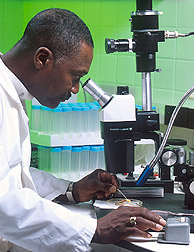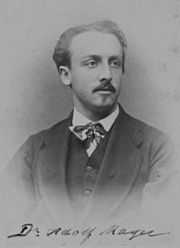https://en.wikipedia.org/wiki/Psychrophile
Psychrophiles or cryophiles (adj. psychrophilic or cryophilic) are extremophilic organisms that are capable of growth and reproduction in low temperatures, ranging from −20 °C to +10 °C. They are found in places that are permanently cold, such as the polar regions and the deep sea. They can be contrasted with thermophiles, which are organisms that thrive at unusually high temperatures. Psychrophile is Greek for 'cold-loving'.
Many such organisms are bacteria or archaea, but some eukaryotes such as lichens, snow algae, fungi, and wingless midges, are also classified as psychrophiles.
Psychrophiles or cryophiles (adj. psychrophilic or cryophilic) are extremophilic organisms that are capable of growth and reproduction in low temperatures, ranging from −20 °C to +10 °C. They are found in places that are permanently cold, such as the polar regions and the deep sea. They can be contrasted with thermophiles, which are organisms that thrive at unusually high temperatures. Psychrophile is Greek for 'cold-loving'.
Many such organisms are bacteria or archaea, but some eukaryotes such as lichens, snow algae, fungi, and wingless midges, are also classified as psychrophiles.
Biology
Habitat
The
cold environments that psychrophiles inhabit are ubiquitous on Earth, as
a large fraction of our planetary surface experiences temperatures
lower than 15 °C. They are present in permafrost, polar ice, glaciers, snowfields and deep ocean waters. These organisms can also be found in pockets of sea ice with high salinity content. Microbial activity has been measured in soils frozen below −39 °C.
In addition to their temperature limit, psychrophiles must also adapt
to other extreme environmental constraints that may arise as a result of
their habitat. These constraints include high pressure in the deep sea,
and high salt concentration on some sea ice.
Adaptations
Psychrophiles are protected from freezing and the expansion of ice by ice-induced desiccation and vitrification
(glass transition), as long as they cool slowly. Free living cells
desiccate and vitrify between −10 °C and −26 °C. Cells of multicellular
organisms may vitrify at temperatures below −50 °C. The cells may
continue to have some metabolic activity in the extracellular fluid down
to these temperatures, and they remain viable once restored to normal
temperatures.
They must also overcome the stiffening of their lipid cell
membrane, as this is important for the survival and functionality of
these organisms. To accomplish this, psychrophiles adapt lipid membrane
structures that have a high content of short, unsaturated fatty acids.
Compared to longer saturated fatty acids, incorporating this type of
fatty acid allows for the lipid cell membrane to have a lower melting
point, which increases the fluidity of the membranes. In addition, carotenoids are present in the membrane, which help modulate the fluidity of it.
Antifreeze proteins are also synthesized to keep psychrophiles' internal space liquid, and to protect their DNA
when temperatures drop below water's freezing point. By doing so, the
protein prevents any ice formation or recrystallization process from
occurring.
The enzymes of these organisms have been hypothesized to engage
in an activity-stability-flexibility relationship as a method for
adapting to the cold; the flexibility of their enzyme structure will
increase as a way to compensate for the freezing effect of their
environment.
Certain cryophiles, such as Gram-negative bacteria Vibrio and Aeromonas spp., can transition into a viable but nonculturable (VBNC) state.
During VBNC, a micro-organism can respirate and use substrates for
metabolism – however, it cannot replicate. An advantage of this state is
that it is highly reversible. It has been debated whether VBNC is an
active survival strategy or if eventually the organism's cells will no
longer be able to be revived.
There is proof however it may be very effective – Gram positive
bacteria Actinobacteria have been shown to have lived about 500,000
years in the permafrost conditions of Antarctica, Canada, and Siberia.
Taxonomic range
The wingless midge (Chironomidae) Belgica antarctica.
Psychrophiles include bacteria, lichens, fungi, and insects.
Among the bacteria that can tolerate extreme cold are Arthrobacter sp., Psychrobacter sp. and members of the genera Halomonas, Pseudomonas, Hyphomonas, and Sphingomonas. Another example is Chryseobacterium greenlandensis, a psychrophile that was found in 120,000-year-old ice.
Umbilicaria antarctica and Xanthoria elegans
are lichens that have been recorded photosynthesizing at temperatures
ranging down to −24 °C, and they can grow down to around −10 °C. Some multicellular eukaryotes can also be metabolically active at sub-zero temperatures, such as some conifers; those in the Chironomidae family are still active at −16 °C.
Penicillium is a genus of fungi found in a wide range of environments including extreme cold.
Among the psychrophile insects, the Grylloblattidae or icebugs, found on mountaintops, have optimal temperatures between 1-4 °C. The wingless midge (Chironomidae) Belgica antarctica can tolerate salt, being frozen and strong ultraviolet, and has the smallest known genome of any insect. The small genome, of 99 million base pairs, is thought to be adaptive to extreme environments.
Psychrotrophic bacteria
Psychrotrophic
microbes are able to grow at temperatures below 7 °C (44.6 °F), but
have better growth rates at higher temperatures. Psychrotrophic bacteria
and fungi are able to grow at refrigeration temperatures, and can be
responsible for food spoilage. They provide an estimation of the
product's shelf life, but also they can be found in soils, in surface and deep sea waters, in Antarctic ecosystems, and in foods.
Psychrotrophic bacteria are of particular concern to the dairy industry. Most are killed by pasteurization;
however, they can be present in milk as post-pasteurization
contaminants due to less than adequate sanitation practices. According
to the Food Science Department at Cornell University,
psychrotrophs are bacteria capable of growth at temperatures at or less
than 7 °C (44.6 °F). At freezing temperatures, growth of psychrotrophic
bacteria becomes negligible or virtually stops.
All three subunits of the RecBCD enzyme are essential for physiological activities of the enzyme in the Antarctic Pseudomonas syringae,
namely, repairing of DNA damage and supporting the growth at low
temperature. The RecBCD enzymes are exchangeable between the
psychrophilic P. syringae and the mesophilic E. coli when
provided with the entire protein complex from same species. However, the
RecBC proteins (RecBCPs and RecBCEc) of the two bacteria are not
equivalent; the RecBCEc is proficient in DNA recombination and repair,
and supports the growth of P. syringae at low temperature, while
RecBCPs is insufficient for these functions. Finally, both helicase and
nuclease activity of the RecBCDPs are although important for DNA repair
and growth of P. syringae at low temperature, the RecB-nuclease activity is not essential in vivo.
Versus psychrotroph
In
1940, ZoBell and Conn stated that they had never encountered "true
psychrophiles" or organisms that grow best at relatively low
temperatures.
In 1958, J. L. Ingraham supported this by concluding that there are
very few or possibly no bacteria that fit the textbook definitions of
psychrophiles. Richard Y. Morita emphasizes this by using the term psychrotroph to describe organisms that do not meet the definition of psychrophiles. The confusion between the terms psychrotrophs and psychrophiles
was started because investigators were unaware of the thermolability of
psychrophilic organisms at the laboratory temperatures. Due to this,
early investigators did not determine the cardinal temperatures for
their isolates.
The similarity between these two is that they are both capable of
growing at zero, but optimum and upper temperature limits for the
growth are lower for psychrophiles compared to psychrotrophs.
Psychrophiles are also more often isolated from permanently cold
habitats compared to psychrotrophs. Although psychrophilic enzymes
remain under-used because the cost of production and processing at low
temperatures is higher than for the commercial enzymes that are
presently in use, the attention and resurgence of research interest in
psychrophiles and psychrotrophs will be a contributor to the betterment
of the environment and the desire to conserve energy.










